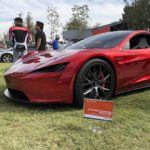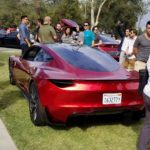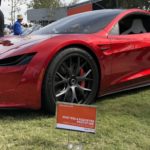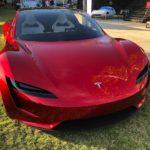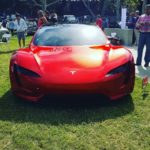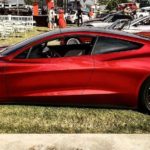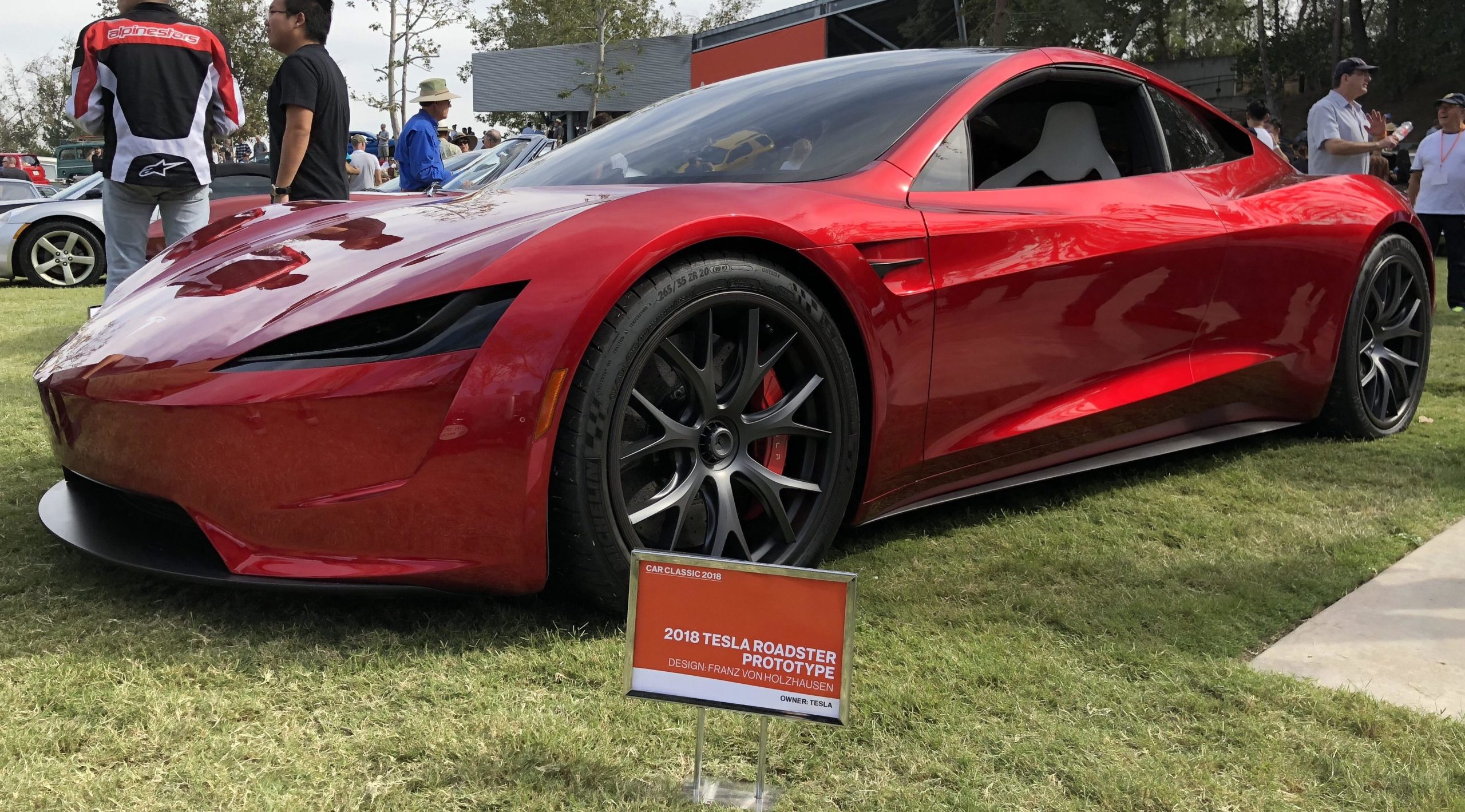
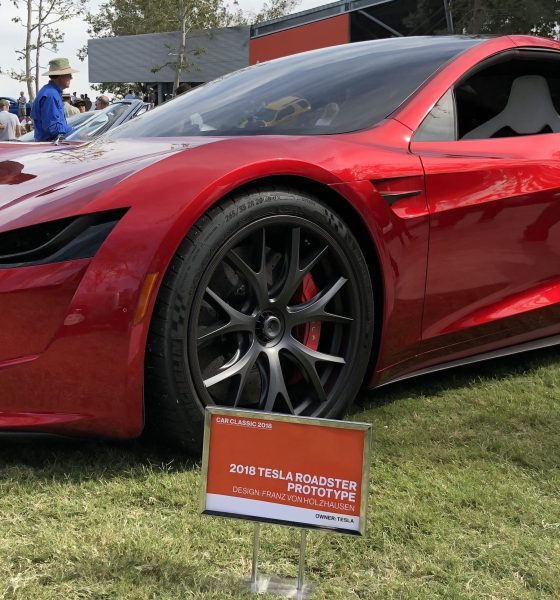
News
Tesla’s next-gen Roadster stuns crowd at famed ArtCenter in Los Angeles
In the world of supercars, there are vehicles that always warrant a second look — cars that are so attractive and iconic; they end up lining the bedroom walls of enthusiasts in their formative years. Decades ago, that car was the Lamborghini Countach and the Ferrari Testarossa. Today, amidst the advent of the electric era, that car is the next-generation Tesla Roadster — a vehicle that Elon Musk aptly dubbed as a “hardcore smackdown” to fossil fuel-powered automobiles.
Tesla’s next-gen Roadster prototype made a rare appearance in Los Angeles over the weekend at the ArtCenter College of Design’s Car Classic 2018 exhibition. The weekend event celebrated the 70th anniversary of the College’s Transportation Design program, which has produced some of the world’s most iconic designers, including Tesla Chief Designer Franz von Holzhausen and Tesla’s Director of Product Design, Javier Verdura. Both are alumni of the Southern California-based ArtCenter who became friends in the early 90s while attending the school’s design program.
Several high-profile vehicles were showcased alongside a gorgeous red Tesla next-generation Roadster at Sunday’s annual car classic, including Henrik Fisker’s EMotion all-electric sports car, a Michelle Christensen-designed Acura NSX, and a Sasha Selipanov/Chris Ha-designed Genesis Essentia concept car.
Attendees of the exhibition took to social media to share stunning images of Tesla’s upcoming all-electric supercar.
- The next-generation Tesla Roadster at Car Classic 2018. [Credit: t35l_4/Instagram]
- The next-generation Tesla Roadster at Car Classic 2018. [Credit: t35l_4/Instagram]
- The next-generation Tesla Roadster at Car Classic 2018. [Credit: dom_schulz/Instagram]
- The next-generation Tesla Roadster at Car Classic 2018. [Credit: Dave Kunz/Instagram]
- The next-generation Tesla Roadster at Car Classic 2018. [Credit: t35l_4/Instagram]
The next-generation Tesla Roadster at Car Classic 2018. [Credit: Dave Kunz, dom_schulz, and t35l_4/Instagram]
Apart from the operational prototype in red, Tesla has also unveiled two design shells for the vehicle — a midnight silver/gray unit that was showcased at Tesla’s Semi truck unveiling event, and a stunning white Roadster that was unveiled at the 2018 Annual Shareholder Meeting. The white Roadster design shell was eventually brought over to the Grand Basel Car Show in Switzerland, where it attracted a notable amount of attention from attendees as well.
Earlier this year, Elon Musk noted on Twitter that the intent behind the creation of the next-generation Tesla Roadster is to “beat gas sports cars on every performance metric by far, no exceptions, thus transferring the “halo crown” effect gas cars have as the top speed leaders over to pure electric.” Tesla’s electric cars today like the Model S P100D and Model X P100D are monsters on the quarter-mile, but when it comes to races over longer distances, they eventually get overtaken by fossil fuel-powered vehicles. The company aims to address this with the upcoming all-electric supercar.
- The next-generation Tesla Roadster at Car Classic 2018. [Credit: dgaultiere/Reddit]
- The next-generation Tesla Roadster at Car Classic 2018. [Credit: Xavier Carr/Instagram]
- The next-generation Tesla Roadster at Car Classic 2018. [Credit: zolinator/Instagram]
- The next-generation Tesla Roadster at Car Classic 2018. [Credit: dom_schulz/Instagram]
- The next-generation Tesla Roadster at Car Classic 2018. [Credit: Dave Kunz/Instagram]
- The next-generation Tesla Roadster at Car Classic 2018. [Credit: dom_schulz/Instagram]
The next-generation Tesla Roadster at Car Classic 2018. [Credit: dgaultiere/Reddit, Dave Kunz, dom_schulz, Xavier Carr, and zolinator/Instagram]
The specs of the next-generation Roadster are remarkable, with its 0-60 mph time of 1.9 seconds, its 0-100 mph time of 4.2 seconds, its top speed of more than 250 mph, its quarter-mile time of 8.9 seconds, and a range of 620 miles per charge thanks to its 200 kWh battery pack. In true Tesla form, the Roadster is poised to be a disruptor in the supercar industry, delivering its knockout performance with a price tag starting at $200,000. This makes it more affordable than mid-level supercars like the McLaren 720S and the Ferrari 812 Superfast (both of which are priced in the ~$300,000 range), despite boasting performance figures that rival (or even exceed) million-dollar “halo cars” like the McLaren P1 and the Ferrari LaFerrari.
What’s even more impressive is that the specs of the all-electric supercar are true for the vehicle’s base version. Earlier this year, Elon Musk announced on Twitter that a “SpaceX package” for the Tesla Roadster, which would use literal rocket thrusters (small Composite Overwrapped Pressure Vessels [COPVs]) from SpaceX, would allow the vehicle to fly “short hops.” In this iteration, Musk noted that the Roadster would lose its 2+2 seating capability, but it would give the all-electric supercar the capability to go even faster. Tesla aims to release the next-generation Roadster sometime in 2020, with test drives estimated to begin towards the end of 2019.

News
Tesla (TSLA) receives “Buy” rating and $551 PT from Canaccord Genuity
He also maintained a “Buy” rating for TSLA stock over the company’s improving long-term outlook, which is driven by autonomy and robotics.

Canaccord Genuity analyst George Gianarikas raised his Tesla (NASDAQ:TSLA) price target from $482 to $551. He also maintained a “Buy” rating for TSLA stock over the company’s improving long-term outlook, which is driven by autonomy and robotics.
The analyst’s updated note
Gianarikas lowered his 4Q25 delivery estimates but pointed to several positive factors in the Tesla story. He noted that EV adoption in emerging markets is gaining pace, and progress in FSD and the Robotaxi rollout in 2026 represent major upside drivers. Further progress in the Optimus program next year could also add more momentum for the electric vehicle maker.
“Overall, yes, 4Q25 delivery expectations are being revised lower. However, the reset in the US EV market is laying the groundwork for a more durable and attractive long-term demand environment.
“At the same time, EV penetration in emerging markets is accelerating, reinforcing Tesla’s potential multi‑year growth runway beyond the US. Global progress in FSD and the anticipated rollout of a larger robotaxi fleet in 2026 are increasingly important components of the Tesla equity story and could provide sentiment tailwinds,” the analyst wrote.
Tesla’s busy 2026
The upcoming year would be a busy one for Tesla, considering the company’s plans and targets. The autonomous two-seat Cybercab has been confirmed to start production sometime in Q2 2026, as per Elon Musk during the 2025 Annual Shareholder Meeting.
Apart from this, Tesla is also expected to unveil the next-generation Roadster on April 1, 2026. Tesla is also expected to start high-volume production of the Tesla Semi in Nevada next year.
Apart from vehicle launches, Tesla has expressed its intentions to significantly ramp the rollout of FSD to several regions worldwide, such as Europe. Plans are also underway to launch more Robotaxi networks in several more key areas across the United States.
News
Waymo sues Santa Monica over order to halt overnight charging sessions
In its complaint, Waymo argued that its self-driving cars’ operations do not constitute a public nuisance, and compliance with the city’s order would cause the company irreparable harm.

Waymo has filed a lawsuit against the City of Santa Monica in Los Angeles County Superior Court, seeking to block an order that requires the company to cease overnight charging at two facilities.
In its complaint, Waymo argued that its self-driving cars’ operations do not constitute a public nuisance, and compliance with the city’s order would cause the company irreparable harm.
Nuisance claims
As noted in a report from the Los Angeles Times, Waymo’s two charging sites at Euclid Street and Broadway have operated for about a year, supporting the company’s growing fleet with round-the-clock activity. Unfortunately, this has also resulted in residents in the area reportedly being unable to sleep due to incessant beeping from self-driving taxis that are moving in and out of the charging stations around the clock.
Frustrated residents have protested against the Waymos by blocking the vehicles’ paths, placing cones, and “stacking” cars to create backups. This has also resulted in multiple calls to the police.
Last month, the city issued an order to Waymo and its charging partner, Voltera, to cease overnight operations at the charging locations, stating that the self-driving vehicles’ activities at night were a public nuisance. A December 15 meeting yielded no agreement on mitigations like software rerouting. Waymo proposed changes, but the city reportedly insisted that nothing would satisfy the irate residents.
“We are disappointed that the City has chosen an adversarial path over a collaborative one. The City’s position has been to insist that no actions taken or proposed by Waymo would satisfy the complaining neighbors and therefore must be deemed insufficient,” a Waymo spokesperson stated.
Waymo pushes back
In its legal complaint, Waymo stated that its “activities at the Broadway Facilities do not constitute a public nuisance.” The company also noted that it “faces imminent and irreparable harm to its operations, employees, and customers” from the city’s order. The suit also stated that the city was fully aware that the Voltera charging sites would be operating around the clock to support Waymo’s self-driving taxis.
The company highlighted over one million trips in Santa Monica since launch, with more than 50,000 rides starting or ending there in November alone. Waymo also criticized the city for adopting a contentious strategy against businesses.
“The City of Santa Monica’s recent actions are inconsistent with its stated goal of attracting investment. At a time when the City faces a serious fiscal crisis, officials are choosing to obstruct properly permitted investment rather than fostering a ‘ready for business’ environment,” Waymo stated.
News
Tesla FSD v14.2.2 is getting rave reviews from drivers
So far, early testers have reported buttery-smooth drives with confident performance, even at night or on twisty roads.

Tesla Full Self-Driving (Supervised) v14.2.2 is receiving positive reviews from owners, with several drivers praising the build’s lack of hesitation during lane changes and its smoother decision-making, among others.
The update, which started rolling out on Monday, also adds features like dynamic arrival pin adjustment. So far, early testers have reported buttery-smooth drives with confident performance, even at night or on twisty roads.
Owners highlight major improvements
Longtime Tesla owner and FSD user @BLKMDL3 shared a detailed 10-hour impression of FSD v14.2.2, noting that the system exhibited “zero lane change hesitation” and “extremely refined” lane choices. He praised Mad Max mode’s performance, stellar parking in locations including ticket dispensers, and impressive canyon runs even in dark conditions.
Fellow FSD user Dan Burkland reported an hour of FSD v14.2.2’s nighttime driving with “zero hesitations” and “buttery smooth” confidence reminiscent of Robotaxi rides in areas such as Austin, Texas. Veteran FSD user Whole Mars Catalog also demonstrated voice navigation via Grok, while Tesla owner Devin Olsen completed a nearly two-hour drive with FSD v14.2.2 in heavy traffic and rain with strong performance.
Closer to unsupervised
FSD has been receiving rave reviews, even from Tesla’s competitors. Xpeng CEO He Xiaopeng, for one, offered fresh praise for FSD v14.2 after visiting Silicon Valley. Following extended test drives of Tesla vehicles running the latest FSD software, He stated that the system has made major strides, reinforcing his view that Tesla’s approach to autonomy is indeed the proper path towards autonomy.
According to He, Tesla’s FSD has evolved from a smooth Level 2 advanced driver assistance system into what he described as a “near-Level 4” experience in terms of capabilities. While acknowledging that areas of improvement are still present, the Xpeng CEO stated that FSD’s current iteration significantly surpasses last year’s capabilities. He also reiterated his belief that Tesla’s strategy of using the same autonomous software and hardware architecture across private vehicles and robotaxis is the right long-term approach, as it would allow users to bypass intermediate autonomy stages and move closer to Level 4 functionality.

